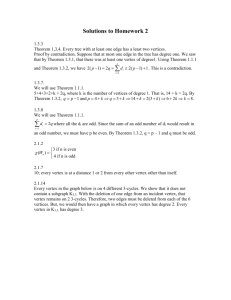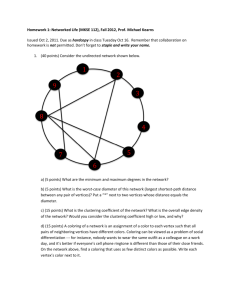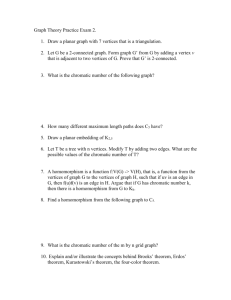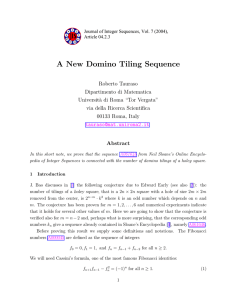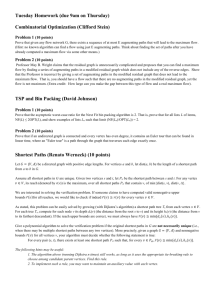Look at notes for first lectures in other courses
advertisement
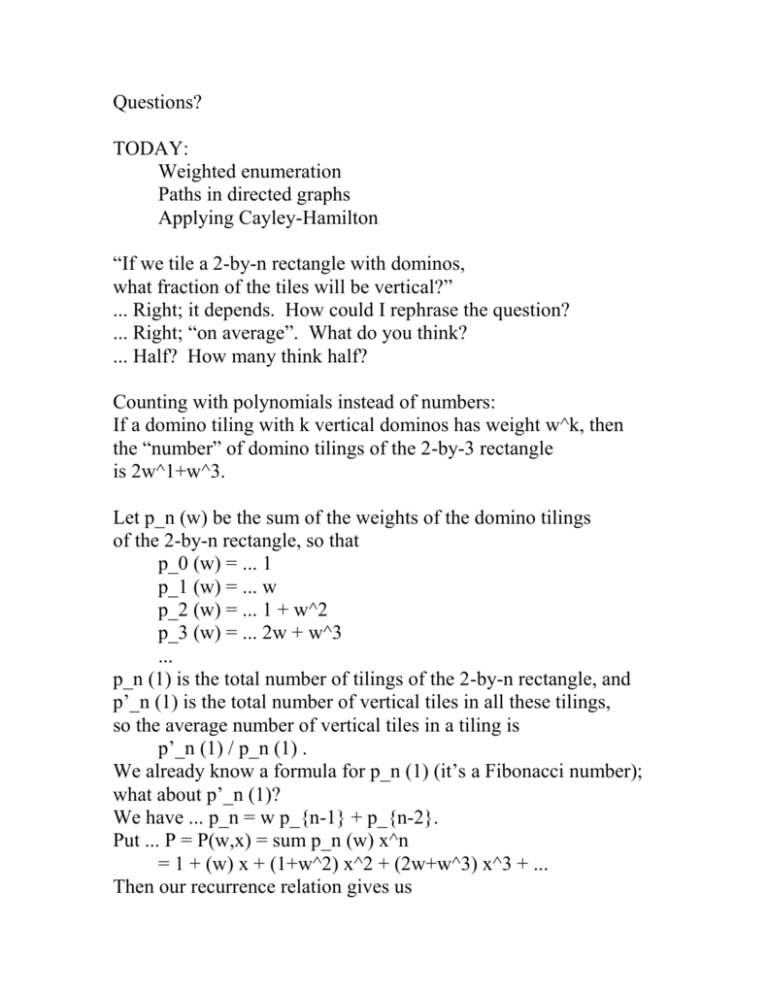
Questions?
TODAY:
Weighted enumeration
Paths in directed graphs
Applying Cayley-Hamilton
“If we tile a 2-by-n rectangle with dominos,
what fraction of the tiles will be vertical?”
... Right; it depends. How could I rephrase the question?
... Right; “on average”. What do you think?
... Half? How many think half?
Counting with polynomials instead of numbers:
If a domino tiling with k vertical dominos has weight w^k, then
the “number” of domino tilings of the 2-by-3 rectangle
is 2w^1+w^3.
Let p_n (w) be the sum of the weights of the domino tilings
of the 2-by-n rectangle, so that
p_0 (w) = ... 1
p_1 (w) = ... w
p_2 (w) = ... 1 + w^2
p_3 (w) = ... 2w + w^3
...
p_n (1) is the total number of tilings of the 2-by-n rectangle, and
p’_n (1) is the total number of vertical tiles in all these tilings,
so the average number of vertical tiles in a tiling is
p’_n (1) / p_n (1) .
We already know a formula for p_n (1) (it’s a Fibonacci number);
what about p’_n (1)?
We have ... p_n = w p_{n-1} + p_{n-2}.
Put ... P = P(w,x) = sum p_n (w) x^n
= 1 + (w) x + (1+w^2) x^2 + (2w+w^3) x^3 + ...
Then our recurrence relation gives us
(1 - wx - x^2) P(w,x) = ... 1
so
P(w,x) = 1 / (1 – wx – x^2).
sum p’_n (w) x^n = (d/dw) 1 / (1 – wx – x^2)
= x / (1 – wx – x^2)^2.
sum p’_n (1) x^n = x / (1 – x – x^2)^2.
(Is this the same as substituting w=1 and then differentiating? ...)
One can use this to get a formula for p’_n (1) / p_n (1).
We’ll come back to this at another time.
SKIP AHEAD?
(Combinatorial interpretation of a_0 = a_1 = x, etc.?)
RESUME
COUNTING PATHS
Problem: How many length-n sequences of 0’s and 1’s are there
such that no two 1’s occur consecutively?
Call this A_n.
A_0 = 1, A_1 = 2, A_2 = 3, A_3 = 5, ...
Equivalently, how many length-n paths (define) are there
through the following network?
Draw picture, with sources and sinks marked.
``Dynamic programming’’
Illustrate, working backwards.
A finite DAG (directed acyclic graph) is a finite set of vertices
with arcs connecting one vertex to another, such that
two vertices are linked by only finitely many arcs, and
there are no infinite paths.
In any finite DAG, there are
only finitely many paths
connecting any two vertices.
Write N(x,y) as the number of paths from x to y.
Note N(x,x) = 1 for all x.
Example: G = {(i,j): i,j geq 0}, arcs connect (i,j) to (i+1,j), (i,j+1)
N((0,0),(m,n)) = (m+n)!/m!n! (binomial coefficients).
{2n choose n} = {n choose k} {n choose k}.
(Later: Catalan paths.)
Theorem: Suppose G is a finite DAG,
x,y are vertices of G,
and B is a set of vertices with the property that
every path from x to y passes through
exactly one vertex in B.
Then N(x,y) = sum_{b in B} N(x,b) N(b,y).
More generally,
suppose A is the set of sources (define) in G
and C is the set of sinks (define) in G,
and that B has the property that
every path from A to C passes through
exactly one vertex in B.
Define the transfer matrix N(A,B) as the matrix
whose (a,b) entry is N(a,b),
and define matrices N(B,C), N(A,C) similarly.
Then
N(A,C) = N(A,B) N(B,C).
Return to example with periodic graph.
Theorem: Suppose the vertex set of G is of
the form V(G) = V_0 union V_1 union ... union V_m
with all sets V_i, V_j disjoint
and with all arcs going from V_i to V_{i+1} for some i,
and suppose that every path from V_1 to V_m
passes through exactly one vertex
in each of the sets V_1,...,V_{m-1}.
Suppose furthermore that the pattern of connections
between V_i and V_{i+1} is independent of i.
Then the transfer matrix from V_i to V_{i+1} is independent of i,
and the transfer matrix from V_0 to V_m
is equal to the mth power of the transfer matrix
from V_0 to V_1.
Theorem: Let G be a semi-infinite DAG
with the symmetry property of the preceding theorem.
Fix a vertex x in V_0
and vertices y_0, y_1, y_2, ... in Y_0, Y_1, Y_2
that are related by the symmetry.
Then the sequence N(x,y_0), N(x,y_1), N(x,y_2), ...
satisfies a dth order linear recurrence equation,
where d = |V_0| = |V_1| = ...
Mention how the example illustrates this.
Proof: Let M be the d-by-d transfer matrix from V_0 to V_1,
and write y = y_0.
Then N(x,y_k) is just the x,yth entry of the matrix M^k.
By the Cayley-Hamilton Theorem,
the matrices M^0=I, M^1=M, M^2, M^3, M^4, ..., M^d
satisfy the linear recurrence relation
M^d + a_1 M^{d-1} + ... + a_n M^{0} = 0,
where t^d + a_1 t^{d-1} + ... + a_n = 0
is the characteristic polynomial of M
(that is, this polynomial is equal to det (tI-M)).
Later in the course, we’ll see a combinatorial proof
of the Cayley-Hamilton Theorem.
It follows that M^n + a_1 M^{n-1} + ... + a_n M^{n-d} = 0
for all;
taking the (x,y)th entry of this matrix equation, we get
N(x,y_n) + a_1 N(x,y_{n-1}) + ... _ a_n N(x,y_{n-d}) = 0,
which is the desired dth order equation.
Work this out explicitly for the Fibonacci example
Re-do domino tilings of the 2-by-n, using cell-labels
Re-do domino tilings of the 2-by-n again, using labels based on
vertical cuts.



